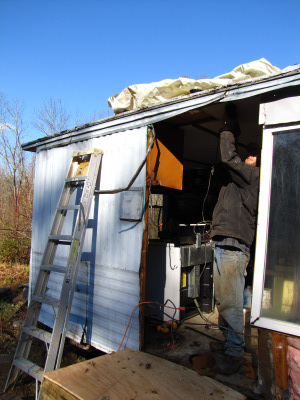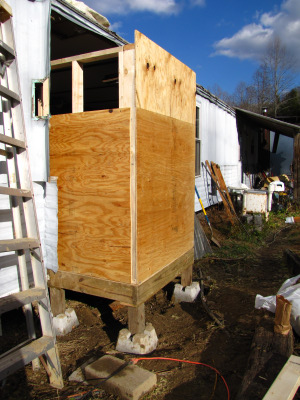
Plumb purty
 Everything
is always easier the second time around, and building is no
exception. Last year, we mulled over every step in our building
project, and I made
so many measuring mistakes that I begged my father not to point them
out when he came to visit.
Everything
is always easier the second time around, and building is no
exception. Last year, we mulled over every step in our building
project, and I made
so many measuring mistakes that I begged my father not to point them
out when he came to visit.
Although we're still
making the odd mistake here and there, our wood
stove alcove project
is flying along. Since we caught up on inside chores during a
rainy Tuesday, we were able to spend all day building on
Wednesday. We cut the piers to size, topped them with a couple of
sill plates for bracket-less joist attachment, then a box of treated
2X6s with an extra one in the middle for an extraordinarily sturdy set
of floor joists. Add a sheet of heavy plywood and we had the
subfloor in place by lunchtime, despite having to tear off the trailer
wall to get to it.
 Next
came the alcove walls. After some head-scratching, we figured out
that if we put three sides of the wall box together on the ground, we
could top it off with the exterior plywood and square the wall in no
time. Then it was just a matter of adding on the top 2X4 and the
ones in the middle and we had plumb walls. Let me tell you,
nothing is plumb in the East Wing, so all of these ninety degree angles
blew me away.
Next
came the alcove walls. After some head-scratching, we figured out
that if we put three sides of the wall box together on the ground, we
could top it off with the exterior plywood and square the wall in no
time. Then it was just a matter of adding on the top 2X4 and the
ones in the middle and we had plumb walls. Let me tell you,
nothing is plumb in the East Wing, so all of these ninety degree angles
blew me away.
Now, if the rain will
just hold off while we put together the ceiling and roof....
Want more in-depth information? Browse through our books.
Or explore more posts by date or by subject.
About us: Anna Hess and Mark Hamilton spent over a decade living self-sufficiently in the mountains of Virginia before moving north to start over from scratch in the foothills of Ohio. They've experimented with permaculture, no-till gardening, trailersteading, home-based microbusinesses and much more, writing about their adventures in both blogs and books.
Want to be notified when new comments are posted on this page? Click on the RSS button after you add a comment to subscribe to the comment feed, or simply check the box beside "email replies to me" while writing your comment.

Sawn edges of laminated materials need to be protected against moisture ingress. This goes for plywood as well as GFRP and CFRP! The water will cause delamination and with plywood this will lead to rot.
So don't forget to really seal the edges of the plywood. Preferably with a two component epoxy or polyurethane. Or the plywood could rot away in as little as five years. A paint will not do the job.
Even for plywood that won't come in direct contact with water? We were careful to get the exterior grade version this time around, and it'll be under the roof where it'll only get occasional splashes.
I've seen plywood slapped on exterior walls and not even painted for years. (Actually, the addition to our house when I was a kid had unpainted plywood panels on the walls. It still seems to be in good shape twenty years later.)
Are you going to put siding over it? If not the plywood will come in contact with water when it rains.
An exterior grade will resist better than an interior grade (a better glue is used). But a cut across the grain of wood will always expose the capillaries in the wood.
The excellent "Handbook of Finnish plywood" states that "care must be taken to prevent the panel edges being subjected to rain, splashing or ground water".
I've never had good luck with Freecyle around here. Even though it covers our area, you really have to go into the big city to pick most anything up, and it's not worth driving an hour each way usually.
The old method of passing things along in rural areas is to lean good things beside the dumpsters rather than tossing them in. That way, people passing by can see them and snag anything they want. But when we were at the newly manned dump the other day, the overseer told me that he's not allowed to let anyone take anything away anymore, since the county is apparently making money off the scrap metal.